1
Joseph Lizotte, Émile's father, bought his first shares in the Compagnie de la Pêche aux marsouins de la Rivière-Ouelle around 1910; at the time this fishery was no longer in operation. Finally, in 1922, he was the sole owner of the 7,200 poles that made up the share capital. Joseph Lizotte paid $0.75 to $1.00 per share.In the meantime, the new shareholder started operating the fishery again. In 1915, at the age of 13, Émile was thought to be old enough to help his father with the family's first beluga fishery.
The family fished twice a year: first, in May and June, then again in August and September. In October, after the belugas left, the Lizottes fished for eel.
Setting up the fishing ground required considerable work. The first step was to cut down 7,200 saplings, one and a half inches in diameter. The Lizottes generally used birch, maple or what is commonly called "scarlet maple," "swamp maple" or "soft maple." The leaves were left on the tops of these trees. The trees used as poles or weirs were sometimes felled more than 50 kilometres from Rivière-Ouelle, then transported by horse-drawn carriage. Émile and his brother Joseph cut the 7,200 poles, which were then removed from the woods and put in piles of around 300 on trailers for transport to Pointe de la Rivière Ouelle.
The end of each pole was sharpened so the points could be driven into sand or clay or through small rocks up to 435 metres from the shore. Poles were installed 60 cm apart in a large "c" shape, also called the "raccroc," totalling roughly three and a half kilometres around. The open part of the "c" faced the end of the point of land where the St. Lawrence and Ouelle River met. During extreme tides in April, when the river reached its lowest and highest levels, several men drove in the poles. Inevitably, these men, who were not wearing waterproof clothing, found themselves up to their waists in icy water. Every spring, this work was repeated and before late summer fishing season, fishing installations were repaired.
Just as when the colony began, belugas arrived in the spring to feed on capelin that spawned near the sandbanks at the river's mouth. The belugas were too busy feeding and were caught at low tide between the sandbanks and the wall formed by the poles. Frightened by the sound of the poles vibrating from wind and waves, few belugas tried to escape.
We now know that hearing is the beluga's most developed sense and that it uses echolocation to get information on its surroundings. In the early days of beluga fishing, the technique used was based solely on visual observations of the animal and its behaviour in certain situations.
2
The last beluga fisherman, Émile Lizotte, tells the story of the family fishery1980
Rivière-Ouelle, Quebec, Canada
 Credits:
Credits:Unknown photographer
3
Émile Lizotte and his wife, Camille Dionne, on their wedding day1930
Rivière-Ouelle, Quebec, Canada
 Credits:
Credits:Unknown photographer
4
Nautical chart, Department of Marine and Fisheries Canada2 July 1923
Rivière-Ouelle, Quebec, Canada
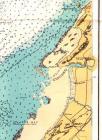 Credits:
Credits:Department of Marine and Fisheries of Canada, Ottawa
5
Beluga fishing area - Rivière-Ouelle in detail25 November 1884
Pointe de la Rivière Ouelle, Rivière-Ouelle, Quebec, Canada
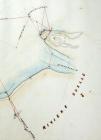 Credits:
Credits:Centre d'archives de la Côte-du-Sud
Collège de Sainte-Anne-de-la-Pocatière collection
Drawing by M. Richard, surveyor, China ink and watercolour on white cardboard
Photograph: Judith Douville
6
Share certificate for the Compagnie de la Pêche aux marsouins de Rivière-Ouelle31 December 1881
Pointe de la Rivière Ouelle, Rivière-Ouelle, Quebec, Canada
 Credits:
Credits:Photograph: Judith Douville
Émile Lizotte (1902?1988)
7
Poles for weir fishing, like those used by Émile Lizotte18 October 2008
Rivière-Ouelle, Quebec, Canada
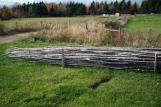 Credits:
Credits:Photograph: Judith Douville
8
Poles making up the beluga fishing "rond" or "raccroc" (curved line)Around 1920
Pointe de la Rivière Ouelle, Rivière-Ouelle, Quebec, Canada
 Credits:
Credits:Centre d'archives de la Côte-du-Sud
Collège de Sainte-Anne-de-la-Pocatière collection (F100/728/10/7)
Unknown photographer
Émile Lizotte (1902?1988)
9
Remnant of the end of a broken pole in the mud18 October 2008
Pointe de la Rivière Ouelle, Rivière-Ouelle, Quebec, Canada
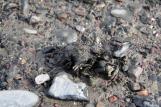 Credits:
Credits:Photograph: Judith Douville
10
Men with beluga catchAround 1925
Pointe de la Rivière Ouelle, Rivière-Ouelle, Quebec, Canada
 Credits:
Credits:Centre d'archives de la Côte-du-Sud
Collège de Sainte-Anne-de-la-Pocatière collection (cf. 5616)
Unknown photographer
Émile Lizotte (1902?1988)
11
Fishermen with their horses in the river's icy watersAround 1925
Pointe de la Rivière Ouelle, Rivière-Ouelle, Quebec, Canada
 Credits:
Credits:Centre d'archives de la Côte-du-Sud
Collège de Sainte-Anne-de-la-Pocatière collection (F100/728/10/1)
Unknown photographer
Émile Lizotte (1902?1988)
12
Men at high tide hauling in the belugas caught in the polesAround 1925
Pointe de la Rivière Ouelle, Rivière-Ouelle, Quebec, Canada
 Credits:
Credits:Collège de Sainte-Anne-de-la-Pocatière collection (F100/728/10/5)
Unknown photographer
Émile Lizotte (1902?1988)
13
Iron spontoon headLate 19th century/early 20th century
Pointe de la Rivière Ouelle, Rivière-Ouelle, Quebec, Canada
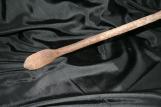 Credits:
Credits:Photograph: Judith Douville
14
Two of Émile Lizotte's harpoons (left) and spontoons used to kill belugasLate 19th century/early 20th century
Pointe de la Rivière Ouelle, Rivière-Ouelle, Quebec, Canada
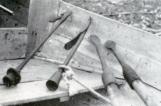 Credits:
Credits:Photograph: Vadim-D. Vladykov
Émile Lizotte (1902?1988)
Vladykov, Vadim-D. "Études sur les mammifères aquatiques." Montreal, Université de Montréal, 1944